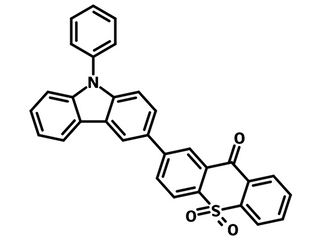TXO-PhCz
CAS Number 1623010-64-9
Dopant Materials, Green Dopant Materials, High Purity Sublimed Materials, Materials,TXO-PhCz, TADF green emitter
High PLQY efficiency and purity, 2-phenyl-4'-carbazole-9H-thioxanthen-9-one-10,10-dioxide, CAS No. 1623010-64-9, Sublimed ≥99.0%
TXO-PhCz is a TADF green emitter with a typical D-A structure consisting with electron withdrawing thioxanthone and electron-donating phenylcarbazole units.
The D-A moieties of TXO-PhCz is angularly linked to provide effective separation of electron densities of the highest occupied molecular orbital (HOMO) and lowest unoccupied molecular orbital (LUMO) in a single molecule.
Small ΔEST of 73 meV for TXO-PhCz is observed resulting efficient reversed intersystem crossing (RISC) and then high photoluminescence quantum yield (PLQY) efficiency.
General Information
| CAS number | 1623010-64-9 |
|---|---|
| Chemical formula | C31H19NO3S |
| Molecular weight | 485.55g/mol |
| Absorption | λmax396 nm (in toluene) |
| Fluorescence | λem522 nm(in toluene) |
| HOMO/LUMO | HOMO = 5.78 eV, LUMO = 3.58 eV [1] |
| Full chemical name | 2-phenyl-4'-carbazole-9H-thioxanthen-9-one-10,10-dioxide |
| Synonyms | TXO-PhCz |
| Classification / Family | Thioxanthone Derivatives, TADF green emitter materials, Sublimed materials |
Product Details
| Purity | Sublimed >99.0% (HPLC) |
|---|---|
| Melting point | TGA: >350 °C(0.5% weight loss) |
| Appearance | Yellow powder/crystals |
*Sublimation is a technique used to obtain ultra pure-grade chemicals. For more details about sublimation, please refer to the Sublimed Materials.
Chemical Structure
Device Structure(s)
| Device structure | ITO/ZnO (20 nm)/Cs2CO3 (5 nm)/BPhen (40 nm)/mCBP:10wt% TXO-PhCz (30 nm)/TAPC (40 nm)/MoO3 (10 nm)/Al (90 nm) [2] |
|---|---|
| Color | Green |
| Max. Current Efficiency | 53.9 cd/A |
| Max. EQE | 16.4 % |
| Max. Power Efficiency | 35.6 Im/W |
| Device structure | ITO (150 nm)/PEDOT (20 nm)/TAPC (20 nm)/mCP (10 nm)/TXO-PhCz:TPBI (5 wt%) (30 nm)/TmPyPB (65 nm)/LiF (0.9 nm)/Al (100 nm) [3] |
|---|---|
| Color | Green |
| Max. Current Efficiency | 71.9 cd/A |
| Max. EQE | 23.2 % |
| Max. Power Efficiency | 45.2 Im/W |
| Device structure | ITO/ZnO (25 nm)/Cs2CO3(7 nm)/Alq3 (30 nm)/T2T (10 nm)/TXO-PhCz:mCBP (10% 30 nm)/TAPC (50 nm)/MoO3 (10 nm)/Al (100 nm) [4] |
|---|---|
| Color | Green |
| Max. Current Efficiency | 28.1 cd/A |
| Max. EQE | 9.8 % |
| Max. Power Efficiency | 16.1 Im/W |
Pricing
| Grade | Order Code | Quantity | Price |
|---|---|---|---|
| Sublimed(>99.0% purity) | M2265A1 | 100 mg | £240 |
| Sublimed(>99.0% purity) | M2265A1 | 250 mg | £480 |
| Sublimed(>99.0% purity) | M2265A1 | 500 mg | £800 |
| Sublimed(>99.0% purity) | M2265A1 | 1 g | £1300 |
MSDS Documentation
Literature and Reviews
- Novel Thermally Activated Delayed Fluorescence Materials–Thioxanthone Derivatives and Their Applications for Highly Efficient OLEDs, H. Wang et al., Adv. Mater., 26(30), 5198-5204 (2014); DOI: 10.1002/adma.201401393.
- n-Doping-induced efficient electron-injection for high efficiency inverted organic light-emitting diodes based on thermally activated delayed fluorescence emitter, Y. Chen et al., J. Mater. Chem. C, 5, 8400-8407 (2017); DOI: 10.1039/C7TC02406A.
- Reduction of the singlet–triplet energy gap of a thermally activated delayed fluorescence emitter by molecular interaction between the host and the emitter, L. Xie et al., J. Mater. Chem. C, 4, 10776 (2016); DOI: 10.1039/c6tc03155b.

